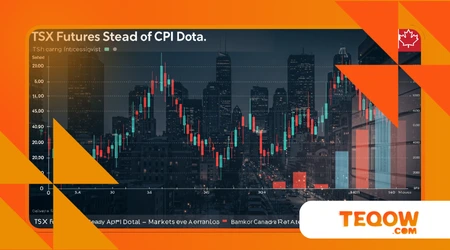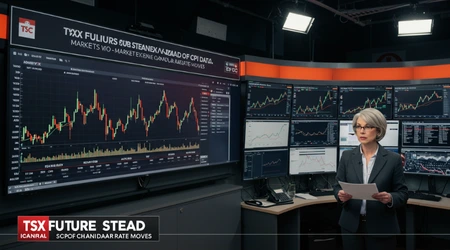TSX Futures Steady Ahead of CPI Data—Markets Eye Bank of Canada Rate Moves

TSX Futures Steady Ahead of CPI Data as Canadian markets hover in anticipation, with investors laser-focused on upcoming inflation figures and potential Bank of Canada (BoC) rate decisions.
The Toronto Stock Exchange (TSX) futures, a barometer of market sentiment, reflect cautious optimism amid global economic shifts.
As inflationary pressures and U.S. trade policies loom, the BoC’s next steps could redefine Canada’s financial landscape.
This article dives into the forces shaping market stability, the implications of CPI data, and what the BoC’s rate moves might mean for investors. Why does this moment feel like a tightrope walk for Canada’s economy?
The Pulse of the Market: Why TSX Futures Are Holding Steady
Investors are treading carefully, with TSX Futures Steady Ahead of CPI Data signaling a market in wait-and-see mode.
The S&P/TSX 60 index futures, up marginally by 0.2% on August 19, 2025, reflect cautious sentiment. This stability stems from anticipation of Canada’s Consumer Price Index (CPI) release, a critical gauge of inflation.
Lower-than-expected inflation could push the BoC toward rate cuts, boosting equities. Conversely, stubborn inflation might delay easing, pressuring stocks. The futures’ calm masks underlying tension, as traders balance hope with uncertainty.
This cautious stance isn’t baseless. Markets are digesting mixed signals from global commodity prices and U.S. trade policies.
For instance, oil prices dipped as investors weighed a potential end to sanctions on Russian crude, which could flood markets and lower energy costs.
++ Canada’s 2025 Wildfire Season Becomes Second Worst on Record
Meanwhile, gold prices, a safe-haven asset, held firm ahead of the U.S. Federal Reserve’s Jackson Hole symposium. These external factors ripple through Canada’s resource-heavy TSX, keeping futures in a holding pattern.
The market’s mood resembles a chess game, with players calculating moves amid uncertainty. Investors are not just watching CPI data; they’re scrutinizing global cues.
The TSX’s resilience, despite tariff threats and geopolitical talks, shows a market poised for clarity. Will the BoC provide the decisive move investors crave?

CPI Data: The Inflation Gauge Driving Investor Sentiment
The CPI report, due this week, is a linchpin for market expectations. Inflation in Canada has hovered near the BoC’s 2% target, but shelter costs remain a sticking point.
Analysts at Macquarie note that shelter prices have propped up inflation, preventing a dovish BoC stance. If CPI data shows cooling, it could signal room for rate cuts, lifting TSX Futures Steady Ahead of CPI Data.
Persistent inflation, however, might force the BoC to hold rates, dampening equity optimism.
Consider the case of Jane, a Toronto-based investor. She’s eyeing energy stocks, expecting lower oil prices to squeeze margins.
If CPI data surprises to the downside, she might pivot to consumer discretionary stocks, betting on rate cuts to spur spending. Her strategy mirrors the market’s sensitivity to inflation signals, where every percentage point matters.
Also read: Bank of Canada Maintains Rate at 2.75%; Additional Cuts Expected in 2025
Historical data underscores this dynamic. In February 2025, U.S. CPI cooled to 2.8% year-over-year, below the expected 2.9%, boosting TSX futures by 0.6%.
Canada’s CPI, closely tied to U.S. trends, could follow suit, influencing BoC policy. Investors are thus glued to this data, knowing it could shift market tides.
| Month | U.S. CPI (Year-over-Year) | TSX Futures Movement |
|---|---|---|
| January 2025 | 3.0% | -0.3% |
| February 2025 | 2.8% | +0.6% |
| March 2025 | 2.9% (projected) | +0.2% |
Bank of Canada’s Rate Path: A Balancing Act
The BoC’s rate decisions are a high-stakes game, with TSX Futures Steady Ahead of CPI Data reflecting investor bets on policy moves.
The BoC held its key rate at 2.75% in July 2025, citing trade tensions and inflation pressures. Traders see a 31.4% chance of a rate cut in September, per Reuters, signaling skepticism about immediate easing.
The bank’s cautious approach stems from U.S. tariff threats, which could spike inflation and disrupt growth.
Imagine a small business owner, Mike, in Calgary. He’s hesitant to expand his manufacturing firm, fearing higher costs from tariffs.
A BoC rate cut could lower borrowing costs, encouraging investment. Without it, he might delay plans, mirroring broader economic caution. The BoC’s decision thus ripples beyond Bay Street, touching real businesses.
Read more: Canada Halts Hotel Housing for Asylum Seekers After Spending $1.1B Since 2020
Governor Tiff Macklem has emphasized economic resilience but flagged trade uncertainties. The bank’s July statement projected modest growth for 2025, with tariffs posing risks.
If CPI data aligns with the 2% target, a cut could come sooner, boosting TSX sectors like financials and consumer staples. Investors are betting on this pivot, but the BoC’s tightrope walk continues.
The interplay of rates and markets is complex. Lower rates typically lift equities by reducing borrowing costs, but persistent inflation could force a pause.
The BoC’s nuanced messaging, as RBC’s Claire Fan noted, balances growth concerns with inflation optimism. This delicate dance shapes the TSX’s trajectory, keeping futures steady but alert.
Global Influences: From Tariffs to Commodities
External forces are tugging at the TSX, with TSX Futures Steady Ahead of CPI Data masking global volatility. U.S. tariff threats, led by President Trump’s policies, have rattled markets.
In March 2025, Trump’s threat to double duties on Canadian steel sparked a 0.72% TSX climb after Ontario dropped a retaliatory levy. This push-and-pull underscores how trade tensions sway investor sentiment.
Commodities, a TSX cornerstone, add another layer. Gold prices, steady at $2,933.43 per ounce in August 2025, reflect safe-haven demand amid U.S.-Russia talks.
Oil, however, slipped as markets eyed Russian supply increases. These shifts impact Canada’s resource stocks, which comprise 30% of the TSX, per Trading Economics. Investors are thus juggling domestic and global signals.
Take Sarah, a fund manager in Vancouver. She’s hedging her portfolio with gold stocks, expecting geopolitical uncertainty to drive prices.
If oil prices drop further, she might trim energy holdings, reflecting the TSX’s commodity sensitivity. Her moves highlight how global dynamics keep futures in check, even as CPI data looms.
The U.S. Federal Reserve’s Jackson Hole symposium adds intrigue. If Fed officials hint at rate cuts, TSX futures could rally, given Canada’s export reliance.
Conversely, a hawkish Fed stance might tighten financial conditions, pressuring Canadian equities. The TSX’s steadiness belies these global currents, making vigilance key.
Corporate News and Sector Impacts
Corporate developments are shaping TSX sentiment, with TSX Futures Steady Ahead of CPI Data reflecting mixed signals.
Air Canada’s recent strike resolution lifted its stock, easing concerns about disrupted forecasts.
Conversely, Bausch + Lomb’s board resignations tied to Carl Icahn’s exit sparked uncertainty, dragging shares down. These events highlight the TSX’s sensitivity to company-specific news.
Sector dynamics add depth. Financials, a TSX heavyweight, could gain from rate cuts, as lower borrowing costs boost lending.
Consumer staples, like Loblaw, which rose 1.2% after a $2 billion investment plan, show resilience. Yet, rate-sensitive tech stocks, down 1.7% in February 2025, face headwinds if rates hold. Investors must navigate these shifts carefully.
Picture a retiree, Tom, relying on TSX dividends. He’s eyeing banks for stability but worries about tech volatility.
If CPI data signals cuts, he might lean into financials. His dilemma reflects broader market trends, where sector performance hinges on BoC moves. The TSX’s balance of gains and losses keeps futures steady but dynamic.
What Lies Ahead: Opportunities and Risks

The road ahead for the TSX is fraught with opportunity and risk, with TSX Futures Steady Ahead of CPI Data as a calm before potential storms.
A favorable CPI report could spur a BoC rate cut, lifting equities. Vanguard Canada projects two cuts by year-end, targeting a 2.25% rate, which could drive TSX gains. However, persistent inflation or tariff escalation might stall this momentum.
Investors face a strategic puzzle. Lower rates could boost consumer spending, benefiting retail stocks. Yet, tariff-driven inflation could squeeze margins, hitting exporters.
The TSX’s 20.79% yearly gain, per Trading Economics, shows resilience, but risks linger. Balancing growth and caution is key, as markets await CPI clarity.
Geopolitical shifts add complexity. U.S.-Russia talks could ease commodity pressures, supporting TSX energy stocks.
Conversely, renewed tariff threats could spark volatility. Investors must stay nimble, using CPI and BoC signals to guide allocations. The TSX’s steadiness offers a window to strategize, but agility is paramount.
Conclusion: Navigating the TSX’s Tightrope
As TSX Futures Steady Ahead of CPI Data, Canada’s markets stand at a crossroads. The upcoming CPI report and BoC rate decisions will shape the TSX’s path, with implications for investors and businesses alike.
Global trade tensions, commodity shifts, and corporate news add layers of complexity, making vigilance essential. The TSX’s resilience, up 20.79% year-over-year, offers hope, but risks like tariffs loom large.
Like a ship navigating choppy waters, investors must steer with precision, using data-driven insights to seize opportunities. Will the BoC’s next move steady the course or rock the boat? Only time and CPI data will tell.
Frequently Asked Questions
What does it mean when TSX futures are steady?
Steady TSX futures indicate stable investor expectations before major data releases, like CPI, reflecting a cautious but balanced market outlook.
How does CPI data impact the TSX?
CPI data influences inflation expectations, guiding BoC rate decisions. Lower CPI could spur rate cuts, boosting TSX stocks, while high CPI may delay easing.
Why is the Bank of Canada’s rate decision critical?
The BoC’s rate moves affect borrowing costs, impacting business investment and consumer spending, which drive TSX performance across sectors.
How do global factors affect TSX futures?
U.S. tariffs, commodity prices, and Fed policies influence Canada’s export-driven economy, swaying TSX futures as investors weigh risks and opportunities.
